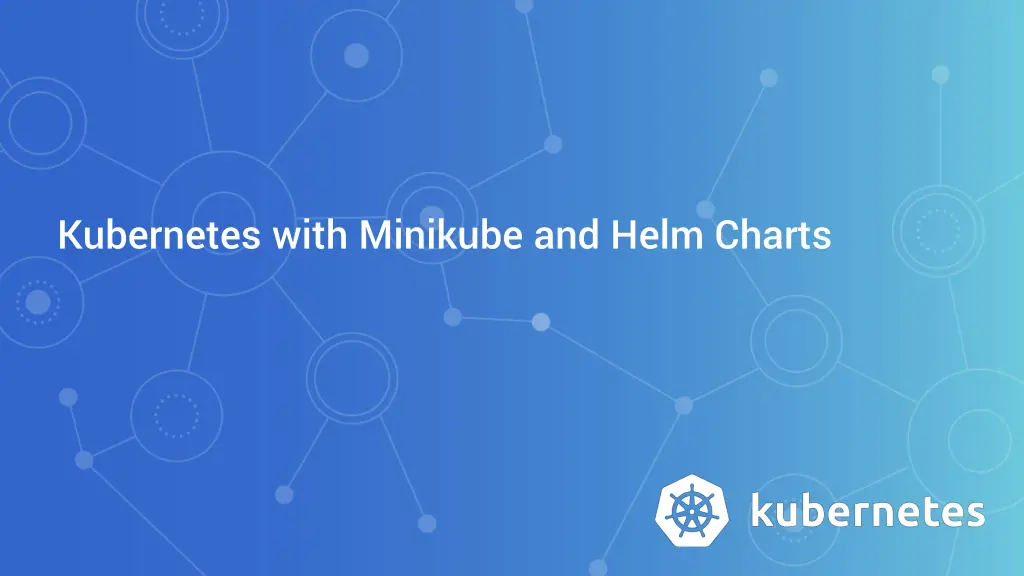
Getting Started with Kubernetes, Minikube, and Helm Charts
"Learn the basics of Kubernetes, setting up Minikube, utilizing Helm Charts, and exploring key concepts and components of cloud-native applications. Dive into deploying and managing Kubernetes applications using Helm and Tiller. Discover diverse deployment options and core components essential for cluster management in this comprehensive guide."
Download Presentation

Please find below an Image/Link to download the presentation.
The content on the website is provided AS IS for your information and personal use only. It may not be sold, licensed, or shared on other websites without obtaining consent from the author. If you encounter any issues during the download, it is possible that the publisher has removed the file from their server.
You are allowed to download the files provided on this website for personal or commercial use, subject to the condition that they are used lawfully. All files are the property of their respective owners.
The content on the website is provided AS IS for your information and personal use only. It may not be sold, licensed, or shared on other websites without obtaining consent from the author.
E N D
Presentation Transcript
Introductions Donald Simpson - John Pikoulas www.automateditsolutions.com Peoples Postcode Lottery Hays
Agenda Recap of previous sessions Kubernetes: options, concepts and components Minikube setup kubectl and VirtualBox My First Cluster and Hello k8s World Helm and Tiller, Helm Charts Some basic examples Next steps
Kubernetes options, options GCP or AWS managed? DIY? Cloud? On Prem? Hybrid?
Kubernetes more options Kubernetes deployment options What s that all about? There are many ways to run K8s, depending on your needs. But today we are doing minikube. And will touch on some of the others
Kubernetes but first this key concepts and components
Concepts Kubernetes Native App architecture The architecture of a typical Cloud-Native application consists of 3-tiers: a persistence or database tier, backend tier and frontend tier for your application. In Kubernetes, you define and create multiple resources for each of these tiers:
Components Core components, control plane components, components we need to manage our cluster: kube-apiserver kube-controller-manager kube-scheduler etcd Runtime components components that basically run our containers and make them available via network: kubelet kube-proxy container runtime
Sailing on with Helm and Tiller
Adding Helm and Tiller Helm: Helm is a tool that streamlines installing and managing Kubernetes applications. Helm runs on your laptop, CI/CD, or wherever you want it to run Tiller: Tiller runs inside of your Kubernetes cluster, and manages releases (installations) of your charts A Gentle Farewell to Tiller, from Helm 3.
Helm Charts Chart: Chart is a Helm package that contains information sufficient for installing a set of Kubernetes resources into a Kubernetes cluster Charts contain a Chart.yamlfile as well as templates, default values (values.yaml), and dependencies. Charts are developed in a well-defined directory structure, and then packaged into an archive format called a chart archive
Minikube, VirtualBox and kubectl Minikube is an open source tool that enables you to run Kubernetes on your laptop or other local machine. It runs a single-node cluster inside a virtual machine on your local machine Kubeadm provides support for most clouds and bare metal with Ansible employed to treat provisioning and orchestration matters
My First Cluster We re first going to setup our components Setup VirtualBox, kubectl, minikube Start our cluster ssh in our cluster Examine our docker running containers Examine our cluster Examine some minikube add ons Examine minikube dashboard Take a look at kubectl command line
Hello (k8s) World Example app deploy "Hello World" nginx docker image Run hello-nginx Get pods Expose deployment Get the service url Get pods Scale cluster pods
Bonus demo Use Helm to deploy Wordpress with MariaDB and Jenkins on our k8s cluster Deploy Jenkins Deploy Wordpress w/MariaDB Helm ls Helm install Help service
What did we do? Introduction to K8s k8s components k8s on your dev laptop Start our first cluster Deploy nginx Increase pod count Deploy Jenkins
